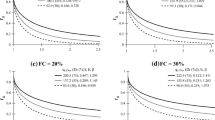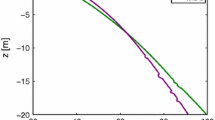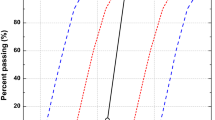Abstract
In this paper the formulation of a simplified model for predicting pore water pressure build-up under seismic loading is updated and applied to different soils. The model is directly based on the results of cyclic laboratory tests and it is based on the damage parameter concept, avoiding any arbitrary equivalence criterion necessary to compare the seismic demand to the cyclic strength of liquefiable soils. The model is suitable to be implemented into non-linear coupled seismic response analyses since it operates in the time domain. The analytical formulation is fully described and the calibration and the physical meaning of the model parameters are analysed in detail. Simple applications show the practical usefulness of the model with respect to other literature approaches.


















Similar content being viewed by others
References
AGI (2005) Aspetti geotecnici nella progettazione in zone sismiche. Guidelines of the Italian Geotechnical Society. Associazione Geotecnica Italiana (in Italian)
Amini F, Qi GZ (2000) Liquefaction testing of stratified silty sands. J Geotech Geoenviron Eng ASCE 126(3):208–217
Annaki M, Lee KL (1977) Equivalent uniform cycle concept for soil dynamics. J Geotech Eng Div ASCE 103(GT6):549–564
Bažant ZP, Krizek RJ (1976) Endochronic constitutive law for liquefaction of sands. J Soil Mech Found Div ASCE 102(EM2):225–238
Biondi G, Cascone E, Di Filippo G (2012) Affidabilità di alcune correlazioni empiriche per la stime del numero di cicli di carico equivalente. Ital Geotech J 2:11–41 (in Italian)
Booker JR, Rahman MS, Seed HB (1976) GADFLEA—A computer program for the analysis of pore pressure generation and dissipation during cyclic or earthquake loading. Earthquake Engineering Center, University of California, Berkeley
Boulanger RW, Idriss IM (2006) Liquefaction susceptibility criteria for silts and clay. J Geotech Geoenviron Eng, ASCE 132(11):1413–1426
Boulanger RW, Idriss IM (2014) CPT and SPT liquefaction triggering procedures. Report No UCD/GCM-14/01, University of California at Davis, California, USA
Burbank M, Weaver T, Lewis R, Williams T, Williams B, Crawford R (2013) Geotechnical tests of sands following bioinduced calcite precipitation catalyzed by indigenous bacteria. J Geotech Geoenviron Eng ASCE 139(6):928–936
Carraro J, Bandini P, Salgado R (2003) Liquefaction resistance of clean and nonplastic silty sands based on cone penetration resistance. J Geotech Geoenviron Eng ASCE 129(11):965–976
Castro G (1975) Liquefaction and cyclic mobility of saturated sands. J Geotech Eng Div ASCE 101(GT6):551–569
Chiaradonna A (2016) Development and assessment of a numerical model per non-linear coupled analysis on seismic response of liquefiable soils. Dissertation, University of Napoli ‘Federico II’
Clough GW, Iwabuchi J, Rad NS, Kuppusamy T (1989) Influence of cementation on liquefaction of sands. J Geotech Eng 115(8):1102–1117
De Alba P, Seed HB, Chan CK (1976) Sand liquefaction in large-scale: simple shear tests. J Geotech Eng Div ASCE 102(GT9):909–927
Derakhshandi M, Rathje EM, Hazirbaba K, Mirhosseini SM (2008) The effect of plastic fines on the pore pressure generation characteristics of saturated sands. Soil Dyn Earthq Eng 28:376–386
Dobry R, Pierce WG, Dyvik R, Thomas GE, Ladd RS (1985) Pore pressure model for cyclic straining of sand. Civil Engineering Department, Rensselaer Polytechnic Institute, Troy
El Hosri MS, Biarez J, Hicher PY (1984) Liquefaction characteristic of silty clay. In: Proceedings of the 8th world conference on earthquake engineering, Prentice-Hall Eaglewood Cliffs, NJ, vol 3, pp 277–284
El Mohtar CS, Bobet A, Drnevich VP, Johnston CT, Santagata MC (2014) Pore pressure generation in sand with bentonite: from small strains to liquefaction. Geotechnique 64(2):108–117
Finn WDL, Bhatia S (1982) Prediction of seismic porewater pressures. In: Proceedings of the 10th international conference on soil mechanics and foundation engineering, Stockholm, Norway, vol 3, pp 201–206
Flora A, Lirer S (2013) Small strain shear modulus of undisturbed gravelly soils during undrained cyclic triaxial tests. Geotech Geol Eng 31(4):1107–1112
GEO-SLOPE International Ltd. (2014) Dynamic modeling with QUAKE/W. An engineering methodology. GEO-SLOPE International Ltd., Calgary, Alberta, Canada. http://downloads.geo-slope.com/geostudioresources/books/8/15/quake%20modeling.pdf. Accessed 23 Mar 2018
Green RA, Terri GA (2005) Number of equivalent cycles concept for liquefaction evaluations—revisited. J Geotech Geoenviron Eng ASCE 131(4):477–488
Green RA, Mitchell JK, Polito CP (2000) An energy-based pore pressure generation model for cohesionless soils. in: John Booker memorial symposium developments in theoretical geomechanics, Rotterdam, The Netherlands, pp 383–390
Hashash YMA, Phillips C, Groholski DR (2010) Recent advances in non-linear site response analysis. In: The 5th international conference in recent advances in geotechnical eartqhuake engineering and soil dynamics, San Diego, CA. CD-Vol OSP 4
Ishihara K, Yasuda S, Nagase H (1996) Soil characteristics and ground damage. Spec Issue Soil Found 36:109–118. https://doi.org/10.3208/sandf.36.Special_109
Ivšić T (2006) A model for presentation of seismic pore water pressures. Soil Dyn Earthq Eng 26:191–199
Khashila M, Hussien MN, Karray M, Chekired M (2017) Use of pore pressure build-up as damage metric in computationof equivalent number of uniform strain cycles. Can Geotech J. https://doi.org/10.1139/cgj-2017-0231
Koester JP, Sharp MK, Hynes ME (1999) Technical bases for Regulatory Guide for soil liquefaction. U.S. Army Corps of Engineers, NRC Job Code W6246
Kondner RL, Zelasko JS (1963) Hyperbolic stress-strain formulation of sands. In: Proceedings of the 2nd panamerican conference on soil mechanics and foundation engineering, Sao Paulo, Brazil. Associação Brasileira de Mecânica dos Solos, vol 1, pp 289–324
Kramer SL, Asl BA, Ozener P, Sideras SS (2015) Effects of liquefaction on ground surface motions. In: Sakr M, Ansal A (eds) Perspective on earthquake geotechnical engineering. Springer, Cham, pp 285–309
Liu AH, Stewart JP, Abrahamson NA, Moriwaki Y (2001) Equivalent number of uniform stress cycles for soil liquefaction analysis. J Geotech Geoenviron Eng ASCE 127:1017–1026
Liyanathirana DS, Poulos HG (2002) Numerical simulation of soil liquefaction due to earthquake loading. Soil Dyn Earthq Eng 22:511–523
Mandokhail SJ, Park D, Yoo JK (2016) Development of normalized liquefaction resistance curve for clean sands. Bull Earthq Eng 15(3):907–929
Matasovic N, Vucetic M (1993) Cyclic characterization of liquefiable sands. J Geotech Eng ASCE 119(11):1805–1822
Montoya-Noguera S, Lopez-Caballero F (2014) Effect of coupling excess pore pressure and deformation on nonlinear seismic soil response. Acta Geotech 11(1):191–207
Nakamichi M, Sato K (2013) A method of suppressing liquefaction using a solidification material and tension stiffeners. In: Proceedings of the 18th international conference on soil mechanics and geotechnical engineering, Paris, France
Papadopoulou A, Tika T (2008) The effect of fines on critical state and liquefaction resistance characteristics of non-plastic silty sands. Soils Found 48(5):713–725
Park T, Ahn JK (2013) Accumulated stress based model for prediction of residual pore pressure. In: Proceedings of the 18th international conference on soil mechanics and geotechnical engineering, Paris, France
Park T, Park D, Ahn JK (2015) Pore pressure model based on accumulated stress. Bull Earthq Eng 13(7):1913–1926
Pekcan O, Çetin KO, Bakir BS (2004) Cyclic Behavior of Adapazari Silt and Clay Mixtures. In Proceeding of the 3rd international conference on earthquake geotechnical engineering—3ICEGE, Berkeley, California, USA
Polito CP (1999) The effects of non-plastic and plastic fines on the liquefaction of sandy soils. PhD Dissertation in Civil Engineering, Virginia Polytechnic Institute, USA
Polito CP, Green RA, Lee J (2008) Pore pressure generation models for sands and silty soils subjected to cyclic loading. J Geotech Geoenviron Eng ASCE 134(10):1490–1500
Porcino D, Diano V (2016) Laboratory study on pore pressure generation and liquefaction of low-plasticity silty sandy soils during the 2012 earthquake in Italy. J Geotech Geoenviron Eng ASCE. https://doi.org/10.1061/(ASCE)GT.1943-5606.0001518
Porcino D, Marcianò V, Granata R (2015) Cyclic liquefaction behaviour of a moderately cemented grouted sand under repeated loading. Soil Dyn Earthq Eng 79:36–46. https://doi.org/10.1016/j.soildyn.2015.08.006
Sandoval EA, Pando MA (2012) Experimental assessment of the liquefaction resistance of calcareous biogenous sands. Earth Sci Res J 16(1):55–63
Seed HB, Idriss IM, Makdisi F, Banerjee N (1975) Representation of irregular stress time histories by equivalent unifrom stress series in liquefaction analyses. Earthquake Engineering Research Center, University of California, Berkeley
Seed HB, Martin PP, Lysmer J (1976) Pore-water pressure changes during soil liquefaction. J Geotech Eng Div ASCE 102(GT4):323–346
Silver ML, Park TK (1976) Liquefaction potential evaluated from cyclic strain-controlled properties tests on sands. Soils Found 16(3):51–65
Swamy KR, Boominathan A, Rajagopal K (2010) Undrained response and liquefaction behavior of non-plastic silty sands under cyclic loading. In: Proceedings of the 5th international conference on recent advances in geotechnical earthquake engineering and soils dynamics, San Diego, California, USA
Sze HY, Yang J (2014) Failure modes of sand in undrained cyclic loading: impact of sample preparation. J Geotech Geoenviron Eng 140(1):152–169
Thevanayagam S, Shenthan T, Mohan S, Liang J (2002) Undrained fragility of clean sands, silty sands and sandy silts. J Geotech Geoenviron Eng 128(10):849–859
Tonni L, Gottardi G, Amoroso S, Bardotti R, Bonzi L, Chiaradonna A, d’Onofrio A, Fioravante V, Ghinelli A, Giretti D, Lanzo G, Madiai C, Marchi M, Martelli L, Monaco P, Porcino D, Razzano R, Rosselli S, Severi P, Silvestri F, Simeoni L, Vannucchi G, Aversa S (2015) Interpreting the deformation phenomena triggered by the 2012 Emilia seismic sequence on the Canale Diversivo di Burana banks. Ital Geotech J 2:28–58 (in Italian)
Troncoso JH, Verdugo R (1985) Silt content and dynamic behaviour of tailing sands. In: 10th International soil mechanics and foundation engineering, vol 3, pp 1311–1314, San Francisco, California
Tropeano G, Chiaradonna A, d’Onofrio A, Silvestri F (2016) An innovative computer code for 1D seismic response analysis including shear strength of soils. Géotechnique 66(2):95–105
Tropeano G, Chiaradonna A, d’Onofrio A, Silvestri F (2018) Numerical model for non-linear coupled analysis of seismic response of liquefiable soils. Computers and Geotechnics (submitted)
USBR (2015) Design Standards No. 13: Embankment Dam. Chapter 13: Seismic Analysis and Design. U.S. Bureau of Reclamation. https://www.usbr.gov/tsc/techreferences/designstandards-datacollectionguides/finalds-pdfs/DS13-13.pdf Accessed 13 May 2017
Valanis KC (1971) A theory of viscoplasticity without a yield surface. Arch Mech (Archiwum Mechaniki Stosowanej) 23(4):517–555
Viana Da Fonseca A, Soares M, Fourie AB (2015) Cyclic DSS tests for the evaluation of stress densification effects in liquefaction assessment. Soil Dyn Earthq Eng 75:98–111
Vucetic M (1994) Cyclic threshold shear strains in soils. J Geotech Eng Div ASCE 120(12):2208–2228
Xenaki V, Athanasopoulos G (2003) Liquefaction resistance of sand-silt mixtures: an experimental investigation of the effect of fines. Soil Dyn Earthq Eng 23(3):1–12
Acknowledgements
This work was carried out as part of WP1 ‘Seismic response analysis and liquefaction’ of the sub-project on ‘Earthquake Geotechnical Engineering’, in the framework of the research programme funded by Italian Civil Protection through the ReLUIS Consortium.
Author information
Authors and Affiliations
Corresponding author
Rights and permissions
About this article
Cite this article
Chiaradonna, A., Tropeano, G., d’Onofrio, A. et al. Development of a simplified model for pore water pressure build-up induced by cyclic loading. Bull Earthquake Eng 16, 3627–3652 (2018). https://doi.org/10.1007/s10518-018-0354-4
Received:
Accepted:
Published:
Issue Date:
DOI: https://doi.org/10.1007/s10518-018-0354-4




